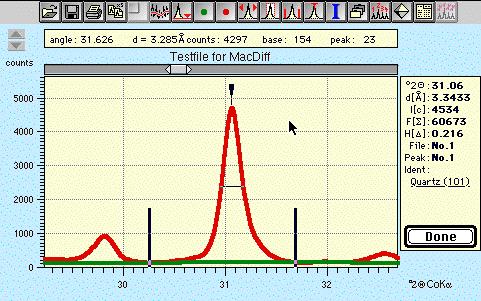|
Welcome to MacDiff! Mac Diff is a programme for analysis and display of X-ray powder diffractogrammes on Apple Macintosh platforms. It is designed as a complement to the XRD applications distributed by Philips or Siemens and it is equipped with a GUI to facilitate user-friendly and interactive processing of XRD profiles. It offers conventional XRD profile-correction processes (e.g. outliers, smoothing, divergence, alpha2-stripping) and supports qualtiative and quantitative phase analysis. Moreover, by its programmable peak analysis (recording of intensities, peak areas, half widths, etc.) it offers an automated analysis of entire series of diffractogrammes. By means of peak fits the contributions of coinciding lines can be calculated. The user has at his disposal the capability of continuous measurement checks and the possibility to perform corrections as well (e.g. by manual or computed background adaptations). For peak indication the user has the option to employ variable peak data sets. High resolution hardcopies of the diffractogrammes can be produced. The standard single-scan formats (Philips-ADP or some Siemens-RAW, ASCII) are identified automatically. Data and plots can be exported to most of the available table-processing or vector-graphics programmes. The applications of MacDiff range from routine analysis in sedimentology, especially clay minerals, over analysis of X-ray diffractogrammes of all types of rocks and minerals all the way to phase analysis of various crystalline substances. MacDiff is freeware and is available to everyone free of charge. It may be copied and distributed without restrictions for non-profit and non-commercial use. All rights reserved. Usage at your own risk. To use MacDiff successfully, please read the manual available in English or German language. If you want to look into changes since last versions read the MacDiff Release Notes. MacDiff is continuously in developement since 1991. If you have questions or observe any bug, and also if you miss a feature, please contact me! |
|
Dr. Rainer Petschick Geologisch-Paläontologisches Institut Johann Wolfgang Goethe-Universität Frankfurt am Main Senckenberganlage 32-34 60054 Frankfurt am Main Germany Tel. 069-798 22694 Fax. 069-798 22958 e-mail: Petschick@em.uni-frankfurt.de |
|
System requirements MacDiff runs on a PowerMacintosh with 8 MB RAM minimum. However, 16 MB with colour monitor is recommended. RAM requirements are 3.5 MB minimum. Hard disk requirements are between 2 and 8 MB memory. All Mac OS-systems older than 8.0 require the extension 'appearance extension' as well as the console 'appearance CDEV', which is available for downloading (name: 'Appearance Lib'). Minimum system: Power Macintosh or first generation PPC-PowerBook (PPC 601) with 14" colour monitor (minimum 256 colours), system 7.1.2 Optimal system (required in particular for profile-adaptations): Power Macintosh or latest generation PPC-PowerBook (604c or G3) with 32 MB RAM minimum, 17 to 21" colour monitor (16 mio. colors), system 8.x Unfortunately, the MacDiff 4.x is not available as 68K-version for earlier processors (68020 to 68040), a consequence of too many cutbacks in performance and more frequent and non-reproducible as well as non-locatable compiler errors. Therefore, the last 68K-version 3.3.1 of October 1997 will remain available and supported by the author. However, an upgrade to PowerMacintosh is recommended for a sensible use of MacDiff. |
|
|
|
Input - Output You can read the following diffractogram files:
|
|
List of some features:
|
|
Example screenshots:
 |
|

|

|
 Peak fit analysis of kaolinite (1) and chlorite (2) (3.58 and 3.54Å). Profile function (blue): Pseudo Voigt (split). Black: curve in common (envelope), grey: residuum curve, red: original data. Background removed. The peak data display shows the data of the 2nd peak (chlorite)
|
|
Acknowledgements:
Rainer Petschick |
|
|